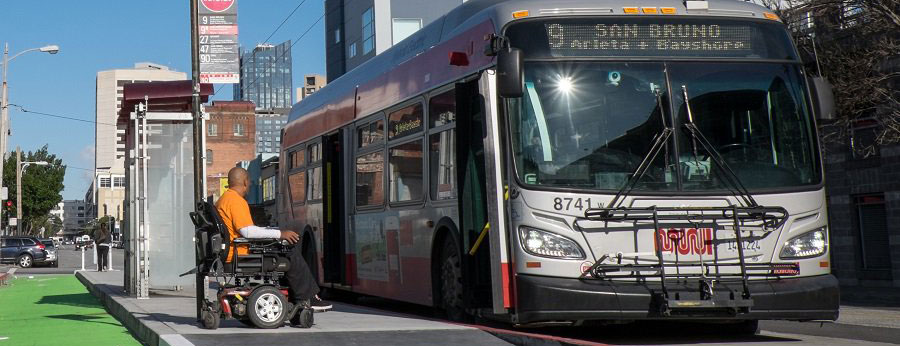Transit

Public Transit Programs
SB 1 provides an additional $350 million in public transit funding each year.
State Transit Assistance (STA) Program: $250 million annually
- This money will go to help transit agencies fund their capital infrastructure and operational costs.
- This money is distributed via current funding formulas based on agency revenue and population.
State of Good Repair Program (SGR): $105 annually
- Funding for transit capital projects or services to maintain or repair existing transit fleets and facilities; new vehicles or facilities that improve existing transit services; or transit services that complement local efforts to repair and improve local transportation infrastructure.
- This money is made available to eligible transit operators based on the STA formula.
For more information about these programs, visit Catrans' State of Good Repair Program page.
Transit and Intercity Rail Capital Program (TIRCP)
TIRCP will receive an additional $300 million annually from SB 1 dollars. These competitive grants fund transformative projects that modernize transit systems, increase ridership, reduce greenhouse gas emissions and improve safety. A minimum of 25% of funding is dedicated to provide direct benefit to disadvantaged communities.
The program helps fund projects that are:
- Significant expansions of commuter and intercity rail
- Major investments in light rail and heavy rail transit projects, involving new corridors as well as expansion of service in existing corridors
- Rollout of expanded services using zero emission buses, both in urban areas, and over longer distance commuter routes.
- Efforts to better serve disadvantaged communities through improved transportation options and reduced emissions in the community
Projects selected in 2018 include:
- Pivotal Improvements for Southern California Region – Investment is focused on critical projects to prepare Los Angeles and the Southern California region for the 2028 Olympic Games with 6 major LA Metro expansion projects receiving funding including light rail extensions to Torrance and Montclair and additional rapid transit service along congested corridors. Additional funding to go towards improving regional commuter and intercity rail to make Pacific Surfliner and Metrolink services faster and more reliable through major investments including track improvements at Los Angeles Union Station.
- Better Connections for the Bay Area – Projects establish the San Jose Diridon station as a Bay Area Regional hub by completing the funding for BART to San Jose, creation of new Samtrans express bus routes to along the congested US-101 corridor and new rail service to Salinas and Monterey, continued support for Caltrain electrification with funding for additional electric trainsets. TIRCP invests in additional new rail vehicles for BART and SF Muni to improve service and reduce train crowding during peak service, and funding for SMART train extensions to connect with Larkspur ferry service and Windsor. Also provides funding for zero-emission vehicles for SolanoExpress and AC Transit.
- Transforming the Central Valley – Supports the creation of an integrated ACE and San Joaquin rail system increasing service frequency in the Central Valley while providing new service connections to Ceres and Sacramento. Provides funding for zero emission bus purchases for Fresno, light rail service improvements for Sacramento Regional Transit, and establishes a new zero-emission intercity bus service connecting the North State to Sacramento.
To learn more, visit our TIRCP page.
State Rail Assistance Program
Senate Bill 1 created the State Rail Assistance Program by directing a portion of new revenue specifically to intercity rail and commuter rail. The majority of program funding is directed by statutory formula to rail operators.
These projects are focused investments by the state to improve commuter and intercity rail service across the state, reduce air pollution and ease traffic congestion.
In total, the SRA Program has awarded funds to 10 agencies with a total of $97.6 million awarded since 2018.
State Rail Assistance provides California's commuter and intercity rail agencies with dependable supplemental revenue that they can use to improve rail service in various ways, including:
- Operations funding for expanded service
- Increased customer amenities such as discounted tickets
- Capital investments such as new and cleaner-emissions rolling stock to increase capacity and reduce emissions
- Track and station investments that can reduce travel times, delays, improve accessibility and enhance the customer experience
In August 2020, the California State Transportation Agency updated its approved application list to reflect additional programming of formula funds by commuter and intercity rail recipients, as well as the deletion of one project awarded flexible funds that has been discontinued by the sponsoring agency.
Complete list of approved projects to date
In March 2019, CalSTA selected 9 State Rail Assistance Projects including:
- Funding for enhanced special events service at Levi’s Stadium, for the Capitol Corridor Joint Powers Authority
- Funding to complete a Coast Rail Corridor Service Implementation Plan for the Coast Rail Coordinating Council system
- Regular special events service by building a Coachella Festival special event train platform in Indio for the Riverside Country Transportation Commission
- Piloting new services to fill key gaps in the rail system in Northern California for Caltrans
Additional transit funding
In addition to these transit dedicated programs, SB 1 also provides additional programs which can help fund transit projects including: